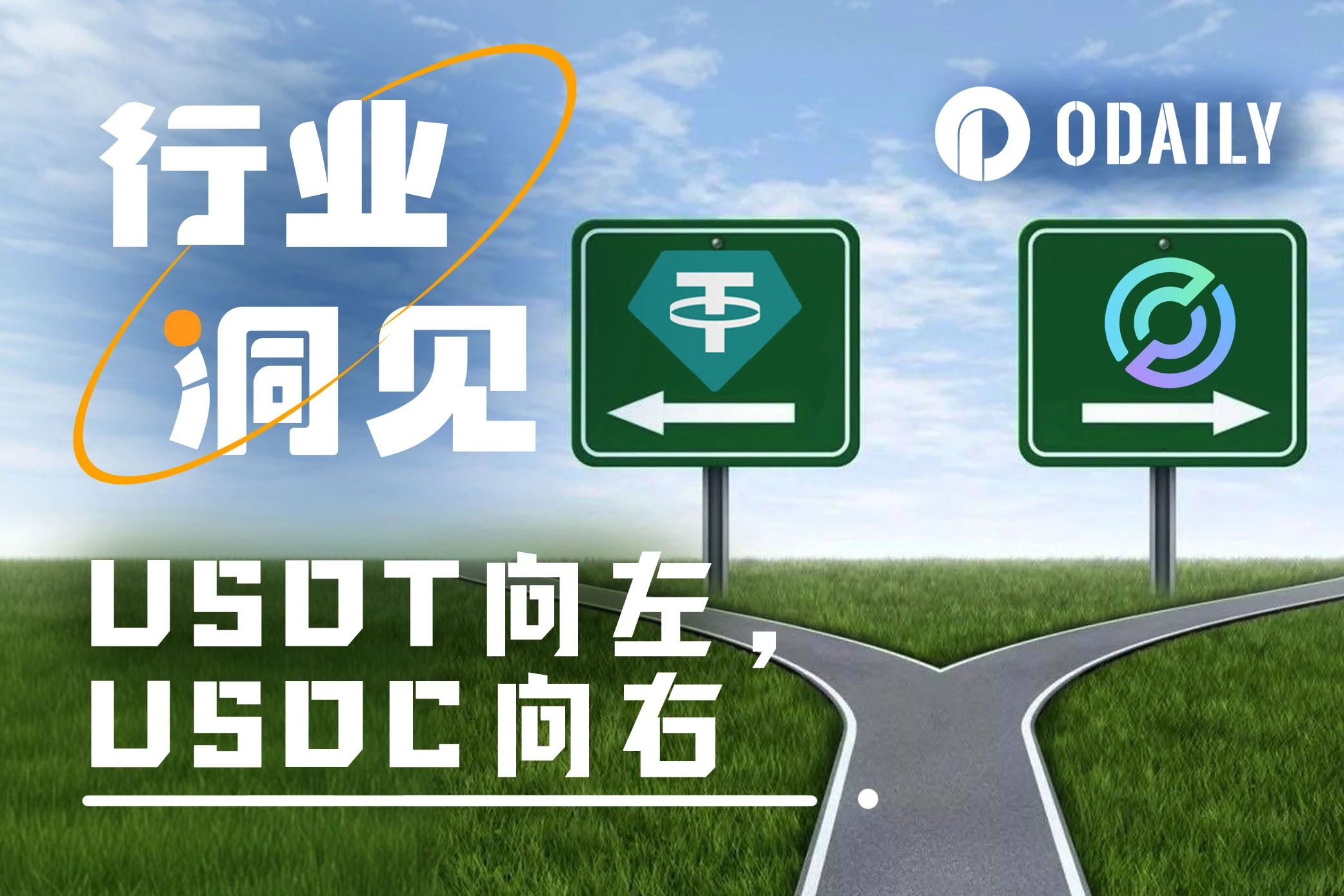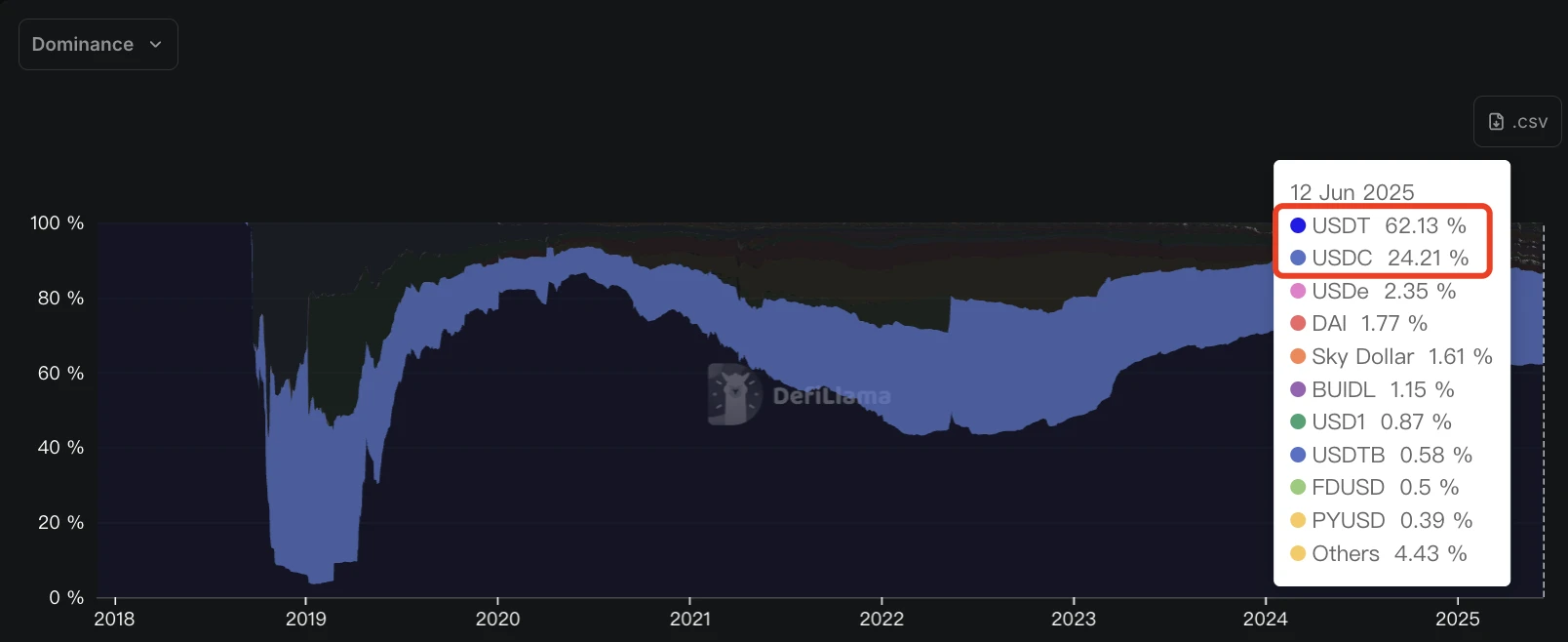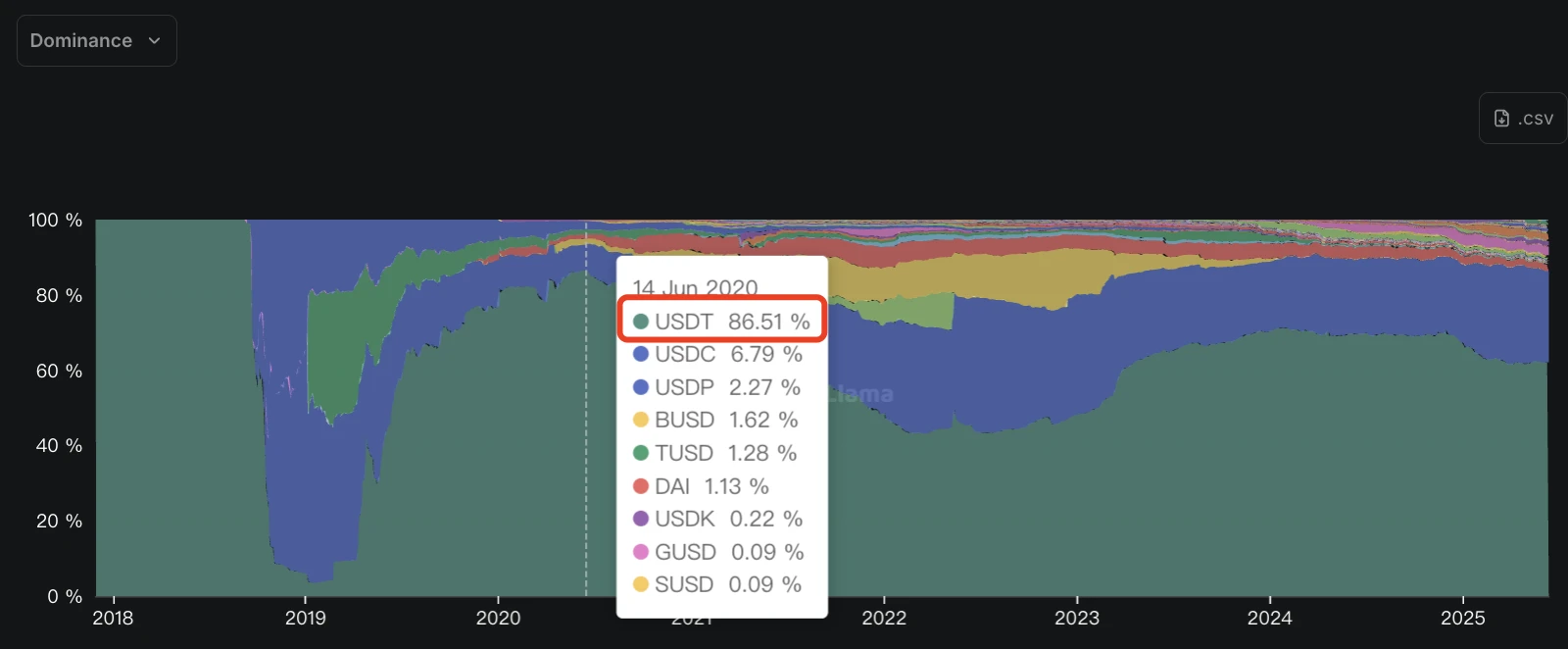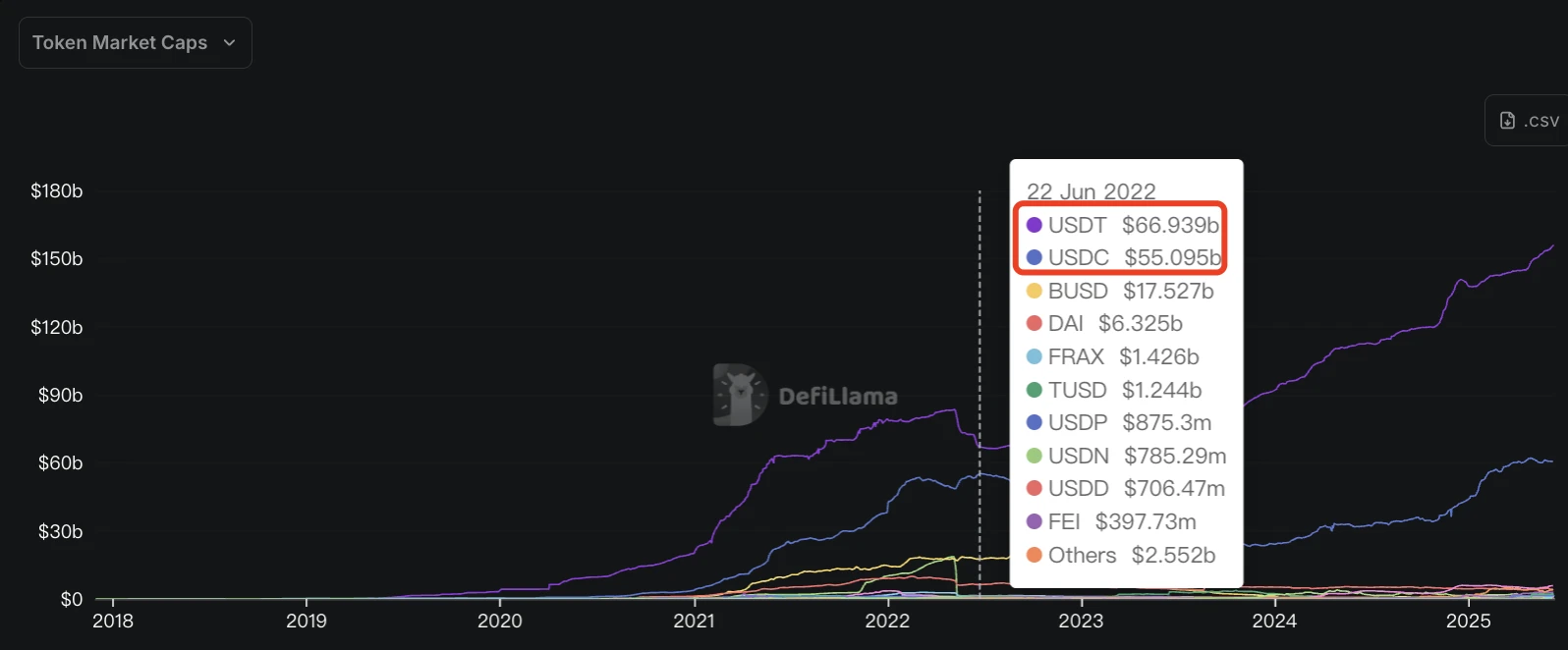Original|Odaily Planet Daily (@OdailyChina)

In the latest news, after a vote of 68 in favor and 30 against, the U.S. Senate has passed the "GENIUS Act." The golden age of stablecoins is about to begin. (Recommended reading: Dollar Hegemony 2.0: How the "GENIUS Act" Reshapes the Global Landscape of Stablecoins?)
Previously, we briefly reviewed the past development of the stablecoin industry in "A Decade of Storms for Stablecoins: Finally Recognized as 'Peer-to-Peer Electronic Cash' by the U.S. Government"; now, with Circle's "first stablecoin stock" making a strong debut on the U.S. stock market with a market value exceeding $20 billion, the distinctions between the second-largest stablecoin USDC and the dominant stablecoin USDT are gradually becoming clear. The former focuses on compliance, subsidies, and yield generation, particularly active in the Solana ecosystem; the latter centers on decentralization, diversified layouts, and real-world payment applications, playing an important role in cross-border trade and global currency.
Odaily Planet Daily will systematically outline the past development and current status of USDT and USDC in this article, attempting to learn from history to trace the future development directions of these two major stablecoin projects.
Stablecoin Landscape Initially Set: The Growth History of the First and Second Dragons
Looking back, the rise of USDT and USDC to their current "first" and "second" positions among stablecoins is no coincidence. The competitive landscape and market performance between the two have, to some extent, become industry indicators akin to a "crypto barometer."
According to DefiLlama data, as of June 12, USDT, the "pioneer of the stablecoin track," issued by Tether since 2014, has long held the "leading position," with a current market value of approximately $156 billion and a market share of 62.1%. USDC, issued by Circle, has remained active in the cryptocurrency market as the "second dragon" of stablecoins, with a current market value of about $60.8 billion and a market share of approximately 24.2%. Other stablecoin projects, including USDe, DAI, Sky Dollar, BUIDL, and USD1, collectively account for less than 15%.
To trace the key points in the "leadership battle" between USDT and USDC, 2019 undoubtedly stands out.

Current Market Share of USDT/USDC
The Dominance of USDT: Partnering with TRON, Seizing DeFi Summer and Global Application Scenarios
In 2019, after a series of turmoil including the theft of 120,000 BTC from its sister company BitFinex, the interruption of cooperation with Tether's reserve bank, and the New York Attorney General's investigation into Tether's reserves, Tether reached an official partnership with the TRON ecosystem.
Since then, after Bitcoin and Ethereum, TRON has become the third ecosystem propelling USDT's rapid growth, gradually becoming the largest network for USDT issuance through initial official subsidies and subsequent energy leasing models. Currently, according to Tether's official website, the issuance of USDT in the TRON ecosystem has reached $78.2 billion, accounting for about 50% of the total USDT issuance, making it "half of USDT's territory."
Additionally, the "liquidity mining craze" spawned by the DeFi Summer in 2020 injected new momentum into USDT's rapid development. As a general equivalent, USDT became the most intuitive "price quantification machine" in the crypto market, serving as the "entry ticket" for many popular DeFi protocols, while the prices of BTC and ETH experienced waves of rapid rises and falls in an increasingly frenzied market environment. To cope with the volatile market, aside from BTC, "holding U" became a choice for many to weather the bear market.
In the real world, USDT gradually became a common intermediary for illegal activities such as money laundering, fraud, drug trafficking, and even human trafficking in Southeast Asia; regions with severe currency inflation, such as South America and the Middle East, also adopted USDT, which is pegged 1:1 to the dollar, as a common tool for daily payments and cross-border transactions.
Against this backdrop, the issuance and market value of USDT experienced exponential growth: in June 2020, the market value of USDT surged to around $9.5 billion, with a market share soaring to 86.5%; USDC's market value was around $1.1 billion, with a market share ranking second in the market at only 6.79%. Other stablecoins, including USDP, BUSD, and TUSD, lagged significantly behind USDT by more than one order of magnitude.
In July 2020, USDT became the first stablecoin project to surpass a market value of $10 billion, thus solidifying its dominant position in the stablecoin track.

Overview of Stablecoin Market Share in 2020
"The Closest Moment of USDC to USDT": During the UST and LUNA Crisis in 2022
Turning the clock back to 2019, it was a painful year for Circle, the issuer behind USDC.
After experiencing a massive market correction in 2018 and the dawn of DeFi Summer, Circle's operating costs had spiraled out of control, and its cash flow was on the brink of collapse. To ensure the company's survival, it reluctantly chose to quickly "lighten its load"—selling the Poloniex exchange, Circle Trade OTC business, and the retail-focused Circle Invest product, while also shutting down and liquidating its previously launched payment application.
Despite making drastic adjustments, by the fall of 2019, Circle found itself once again on the brink of bankruptcy. It was then that Circle had to face its own do-or-die moment: ALL IN on USDC.
Focusing on the main business often marks the beginning of a company's rebirth from the brink of death.
In March 2020, Circle's platform underwent an upgrade, and the USDC account system along with a complete set of new APIs emerged, greatly facilitating developers in seamlessly integrating banking, card payment systems, and other payment systems into their applications. The deposit and withdrawal operations for USDC became smoother, and Circle finally got back on track.
By the end of 2020, the circulation of USDC skyrocketed from $400 million at the beginning of the year to nearly $4 billion, an increase of nearly tenfold. Of course, USDT's growth was equally astonishing, with its market value surging to around $20 billion, making it the absolute leader among stablecoins.
It is worth mentioning that the global COVID-19 pandemic provided a certain boost to the development of on-chain stablecoins like USDT and USDC. After all, compared to the cumbersome processes and complex procedures of traditional banking systems, stablecoin payments in the cryptocurrency industry are more flexible, convenient, and cost-effective.
For USDC, the moment it came closest to USDT's market value occurred in June 2022.
At that time, influenced by the collapse of the algorithmic stablecoin UST and LUNA under Terra Labs, panic and FUD regarding "USDT's imminent de-pegging" resurfaced in the market. In extreme cases, Tether, the issuer behind USDT, quickly processed about $7 billion in redemptions within 48 hours, nearly 10% of its then-reserve amount, marking the most extreme stress test.
At that time, USDT's market value fell to around $66.9 billion; meanwhile, USDC, backed by Coinbase and adhering to compliance and sufficient reserves, experienced a surge, with its market value increasing to around $55 billion, narrowing the gap between the two to less than $12 billion.

Comparison of Market Value Gap Between USDT and USDC in June 2022
But subsequently, USDT, which does not require "supply" and has a more diversified business model and broader application scenarios, gradually outpaced its competitors, while USDC, constrained by profit-sharing conditions with partners like Coinbase and Binance, despite also experiencing rapid growth in market value, fell short in net profit compared to Tether, which has an annual net profit exceeding $10 billion.
From the initial team composition and subsequent development direction, the development paths of USDT and USDC may have been predetermined.
USDT's Choice: Moving Left Towards Decentralized Intermediation
For USDT and its parent company Tether, they have chosen a "leftward path"—to become a decentralized intermediary service provider.
In this context, aside from Tether's founder and CEO Paolo Ardoino, another key figure often overlooked by the public is Giancarlo Devasini, who holds a 40% stake in Tether. Devasini previously worked in plastic surgery before transitioning to the import of electronic products and software reselling, even engaging in the trade of pirated software. Thanks to his extraordinary risk-taking spirit and unorthodox business methods, Devasini's personal net worth has grown to approximately $9.2 billion, at one point surpassing that of Piero Ferrari, the son of the famous luxury car company Ferrari's founder, Enzo Ferrari.

"The Giant Behind Tether"
His aggressive business philosophy and bold operational methods have led Tether to misappropriate user funds for interest-generating investments, raising ongoing market questions about whether Tether possesses sufficient reserves. When collaborating with Puerto Rico's Silver Bank to deposit funds, after insisting on investing in profitable bonds and being rejected by the bank's founder John Betts, Devasini bluntly stated: "We need to take our clients' funds to invest in bonds; we need more income and do not need to respond to critics by doing so much."
For the rapidly growing cryptocurrency industry, perhaps street smarts can make a crypto project more resilient.
Despite previously encountering a series of controversies and even excessive issuance, Tether has managed to navigate the edges of regulation and compliance, becoming what CEO Paolo Ardoino recently referred to at a Bitcoin conference as a—"decentralized infrastructure provider."
As Paolo described—
“Financial and big tech companies often rely on layers of intermediaries: financial intermediaries charge fees on every transaction, while tech giants control our data. Essentially, it’s the same issue: we lose sovereignty over both money and data. Tether's goal is to provide tools through technology to help people break free from these intermediaries and achieve true individual sovereignty.”
Indeed, this is the story Tether tells—a service provider supporting sovereign individuals against traditional big tech and finance companies, a decentralized stablecoin project that does not care about the user's identity, nationality, age, gender, or intended use.
Specifically, the advantages of USDT issued by Tether mainly include:
Reserve fund audits conducted by Tether's partner accounting firm BDO, which essentially operates in a black box. This situation is expected to improve with the introduction of the U.S. stablecoin regulatory bill, the "GENIUS Act," at which point Tether may publish annual, quarterly, and even monthly transparency reports;
USDT exists on a blockchain network, with transaction records stored on a decentralized blockchain, ensuring transparency and immutability; users have direct control over USDT assets in non-custodial wallets; it can circulate freely in DeFi protocols, DEXs, CEXs, and other scenarios.
As a centralized issuer, Tether has complete control over the issuance, redemption, and reserve management of USDT, and can freeze USDT assets in specific addresses through blacklist permissions (e.g., in cases of illegal activities). Tether was also one of the parties that assisted in the handling of the "Bybit $1.5 billion asset theft case."
Yes, you read that correctly; the value stability and convertibility of USDT heavily rely on Tether's reputation. As frequent users of USDT, we can only hope that Tether will not make a reckless decision to easily destroy this business that generates over $10 billion in annual net profit.
Additionally, according to Tether's subsequent development plans, its initiatives encompass mining, AI, digital agriculture, education, mobile communications, and many other sectors, undoubtedly revealing the ambitious and adventurous attitude of this stablecoin giant.
In the latest news, Tether CEO Paolo Ardoino also shared news on social media about a U.S. bank's upcoming stablecoin issuance, captioning it "Select your player," which seemingly hints at a potential collaboration between the two.
USDC's Decision: Moving Right to Embrace a Centralized Compliance System
In contrast to Tether, Circle has taken a more cautious, arduous, yet solid centralized compliance route.
Specifically, as Circle CEO Jeremy Allaire mentioned in "How I Went All In on Stablecoins Seven Years Ago":
Circle was the first company in the crypto industry to obtain a full set of compliance licenses from the ground up, the first crypto company to receive an Electronic Money Institution (EMI) license in Europe, and the first to obtain the so-called "BitLicense" in New York—this was the first regulatory license specifically established for the crypto industry. For nearly a year after that, we were the only ones holding this license.
We have always adhered to the principle of "regulation first," consistently choosing to take the "front door" route to ensure we have a good and robust compliance system. By the way, it is precisely because of this compliance foundation that we can achieve another key goal: liquidity. What is liquidity? It means you can truly create and redeem stablecoins, connect to real bank accounts, and use fiat currency to buy and redeem stablecoins. If you are a suspicious offshore company, no one will want to open a bank account for you, and you simply cannot do these things. You might not even know where your bank is.
Circle was the first company to establish high-quality banking partnerships and introduced strategic partners like Coinbase to distribute USDC on a large scale at the retail level, allowing any ordinary user with a bank account to easily buy and redeem USDC. We also provide institutional-level services. In other words, from transparency, compliance, and regulatory framework to actual liquidity, we have achieved it all.
Regarding Circle's business composition and profit sources, details can be found in our previous article "Will Circle's IPO Be Delayed? What Is the Valuation of the 'First Stablecoin Stock'?". Currently, Circle primarily relies on reserve interest for revenue, a situation that may change after its IPO.
It is worth mentioning that Circle's compliance efforts are indeed solid: it is registered in the U.S. as a Money Services Business (MSB) and complies with relevant regulations such as the Bank Secrecy Act (BSA); it holds money transmission licenses in 49 U.S. states, Puerto Rico, and Washington D.C.; in 2023, Circle received a Major Payment Institution license from the Monetary Authority of Singapore (MAS), allowing it to operate in Singapore; in 2024, Circle obtained an Electronic Money Institution (EMI) license from the French Prudential Supervision and Resolution Authority (ACPR), enabling it to issue USDC and EURC in Europe under the EU's Markets in Crypto-Assets (MiCA) regulation.
In the future, USDC's rightward path may wave the banner of "American nationalism," leveraging favorable regulatory policies to further expand its global footprint and shine in institutional-level payments, PayFi, and TradFi sectors, while also providing some support or monetary assistance for plans like the Trump administration's digestion of U.S. debt and Bitcoin strategic reserves.
Thanks to the rapid development of the Solana ecosystem and the PayFi sector, USDC's future as the main circulating stablecoin in this ecosystem is also promising.
Conclusion: You Reap What You Sow
Looking at the development history of USDT and USDC, as well as the rise of stablecoin issuers like Tether and Circle, after more than a decade, the persistence and dedication of the past have finally borne fruit, with stablecoins taking root and blossoming as "peer-to-peer electronic payment systems."
One firmly adheres to the mass line, while the other emphasizes differentiated development through compliance operations, opening new avenues for the subsequent development ceilings of USDT and USDC: the former's market encompasses hundreds of trillions to millions of trillions of dollars in cross-border trade and daily payments; the latter's market is the overall scale of over $100 trillion in global legal electronic currency.
The previous round of competition in the cryptocurrency industry has come to a close, and a new round of competition has quietly begun following the formal implementation of the "GENIUS Act."
Recommended Reading:
Bloomberg Reporter Zeke Faux Reveals the Giant Behind Tether: Giancarlo Devasini
免责声明:本文章仅代表作者个人观点,不代表本平台的立场和观点。本文章仅供信息分享,不构成对任何人的任何投资建议。用户与作者之间的任何争议,与本平台无关。如网页中刊载的文章或图片涉及侵权,请提供相关的权利证明和身份证明发送邮件到support@aicoin.com,本平台相关工作人员将会进行核查。



